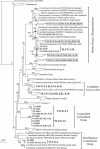Archaea in Yellowstone Lake
- PMID: 21544103
- PMCID: PMC3197168
- DOI: 10.1038/ismej.2011.56
Archaea in Yellowstone Lake
Abstract
The Yellowstone geothermal complex has yielded foundational discoveries that have significantly enhanced our understanding of the Archaea. This study continues on this theme, examining Yellowstone Lake and its lake floor hydrothermal vents. Significant Archaea novelty and diversity were found associated with two near-surface photic zone environments and two vents that varied in their depth, temperature and geochemical profile. Phylogenetic diversity was assessed using 454-FLX sequencing (~51,000 pyrosequencing reads; V1 and V2 regions) and Sanger sequencing of 200 near-full-length polymerase chain reaction (PCR) clones. Automated classifiers (Ribosomal Database Project (RDP) and Greengenes) were problematic for the 454-FLX reads (wrong domain or phylum), although BLAST analysis of the 454-FLX reads against the phylogenetically placed full-length Sanger sequenced PCR clones proved reliable. Most of the archaeal diversity was associated with vents, and as expected there were differences between the vents and the near-surface photic zone samples. Thaumarchaeota dominated all samples: vent-associated organisms corresponded to the largely uncharacterized Marine Group I, and in surface waters, ~69-84% of the 454-FLX reads matched archaeal clones representing organisms that are Nitrosopumilus maritimus-like (96-97% identity). Importance of the lake nitrogen cycling was also suggested by >5% of the alkaline vent phylotypes being closely related to the nitrifier Candidatus Nitrosocaldus yellowstonii. The Euryarchaeota were primarily related to the uncharacterized environmental clones that make up the Deep Sea Euryarchaeal Group or Deep Sea Hydrothermal Vent Group-6. The phylogenetic parallels of Yellowstone Lake archaea to marine microorganisms provide opportunities to examine interesting evolutionary tracks between freshwater and marine lineages.
Figures




References
-
- Aguilar C, Cuhel RL, Klump JV.Porewater and hydrothermal vent water inputs to Yellowstone Lake, WyomingIn: Anderson RJ, Harmon D (eds).Yellowstone Lake: Hotbed of Chaos or Reservoir of Resilience?Proceedings of the Sixth Biennial Scientific Conference on the Greater Yellowstone Ecosystem; 8–10 October 2001; Mammoth Hot Springs Hotel, Yellowstone National Park. Yellowstone Center for Resources and George Wright Society: Hancock, MI; 20021–18.
-
- Altschul SF, Gish W, Miller W, Myers EW, Lipman DJ. Basic local alignment search tool. J Mol Biol. 1990;215:403–410. - PubMed
-
- Auguet J-C, Borrego CM, Bañeras L, Casamayor EO. Fingerprinting the genetic diversity of the biotin carboxylase gene (accC) in aquatic ecosystems as a potential marker for studies of carbon dioxide assimilation in the dark. Environ Microbiol. 2008;10:2527–2536. - PubMed
-
- Baker GC, Smith JJ, Cowan DA. Review and re-analysis of domain-specific 16S primers. J Microbiol Methods. 2003;55:541–555. - PubMed
-
- Balistrieri LS, Shanks WC, III, Cuhel RL, Aguilar C, Klump JV.The influence of sub-lacustrine hydrothermal vents on the geochemistry of Yellowstone LakeIn: Anderson RJ, Harmon D (eds).Yellowstone Lake: Hotbed of Chaos or Reservoir of Resilience?Proceedings of the Sixth Biennial Scientific Conference on the Greater Yellowstone Ecosystem; 8–10 October; Mammoth Hot Springs Hotel, Yellowstone National Park. Yellowstone Center for Resources and George Wright Society: Hancock, MI; 2007169–199.
Publication types
MeSH terms
Substances
LinkOut - more resources
Full Text Sources
Molecular Biology Databases
Research Materials

